Japan
Wood Products Prices
Dollar Exchange Rates of 10th
October
2025
Japan Yen 152.29
Reports From Japan
GDP growth supported by exports
In the latest Dai-Ichi Life research Institute’s ‘Japan
Economic Outlook’ analyst Yoshiki Shinke reports Japan's
real GDP growth rate for the April-June quarter of 2025
posted a strong annualised gain of +2.2% from the
previous quarter supported by resilient exports and
business investment which had been considered vulnerable
to the adverse effects of the US tariffs. However, the
negative effects of the tariff hikes are highly likely to
emerge going forward.
Yoshiki suggests personal consumption in Japan is
expected to remain broadly stagnant. Although personal
consumption grew relatively strongly in the April-June
quarter with a quarter-on-quarter increase of +0.4%, the
sustainability of this momentum is questionable given the
persistent high level of prices.
Against this backdrop, as the negative effects of tariff
increases gradually materialise, the business sector is
forecast to slow down, resulting in the Japanese economy
in the latter half of 2025 remaining in a state of stagnation
with intermittent progress and setbacks.
See:https://www.dlri.co.jp/english/report_en/202509YS.html
Business sentiment slides
Business conditions fell to a new low in August according
to the preliminary coincident index which tracks economic
conditions including factory output, employment and retail
sales. The index is compiled and published by the Cabinet
Office.
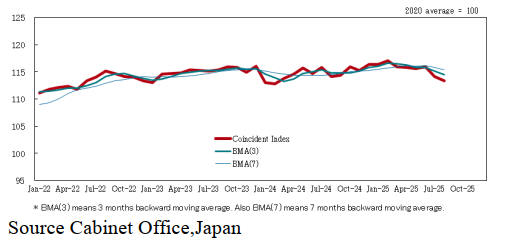
Uptick in consumer confidence in September
Japan's seasonally adjusted Consumer Confidence Index
increased by 0.4 points in September when compared to
the previous month, coming in at 35.3, according to
Thursday's report by the country's Cabinet Office.
The overall livelihood index went up by 0.5 points from
the previous month to reach 33.2, while the employment
index marked a 0.6 point increase, ending up at 39.9. The
income growth indicator remained unchanged at 39.4, with
the willingness to buy durable goods up by 0.8 points to
28.8.
The percent of respondents who expect prices to increase
over the next year was 93%, unchanged from the previous
month, while 2% of those surveyed see them unchanged
and 2% expect prices to fall.
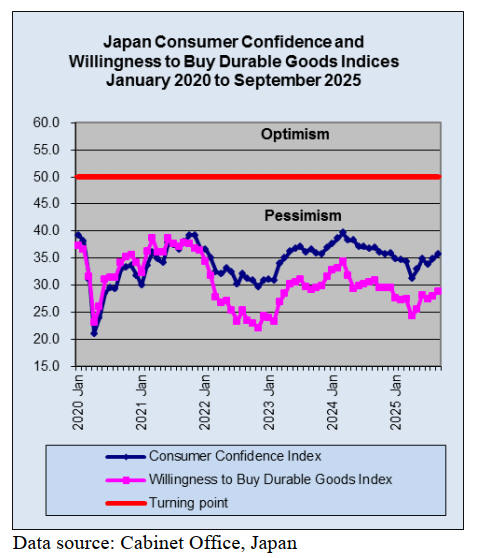
Turmoil in domestic politics as coalition crumbles
The political fortunes of Sanae Takaichi, the newly elected
president of the Liberal Democratic Party (LDP), dimmed
dramatically after the LDP’s coalition partner declared it is
withdrawing from the coalition which put her path to
becoming Japan’s first woman prime minister in jeopardy.
Just before the election the Japanese currency was trading
around yen 147 to the dollar. After the victory of Takaichi
and the departure of the coalition partner it quickly lost
value dropping to yen153-155.
The outlook for the yen is far from certain. Its weakness is
a function of a number of factors. The interest rate
differential between Japan and the United States is widely
seen as the primary reason for the weakening of the yen.
Analysts suggest other factors such as domestic political
instability and expectations for continued monetary
stimulus are also having an impact. A weak yen increases
import costs which eventually leads to price increases.
Atsushi Takeuchi, a former Bank of Japan official,
suggested Japanese authorities may tolerate moderate yen
decline but could intervene if the currency depreciates
towards 160 to the dollar.
Many observers see 160 yen per dollar as the limit after
which there would be a greater chance of currency
intervention. Finance Minister, Katsunobu Kato, said on
Friday the authorities were monitoring excessive,
disorderly exchange-rate moves.
BOJ rate hike still a possibility
Inflation, fueled by currency depreciation, remains risk to
Japan's economy. The current political turmoil has led
most analysts to rule out an interest rate hike when the
Bank of Japan next meets in late October but an increase
at one of the BOJ's winter meetings could be possible
depending on the movement of the yen.
See:
https://www.japantimes.co.jp/business/2025/10/10/markets/takai
chi-yen-plunge/
and
See: https://www.reuters.com/world/asia-pacific/japan-may-
intervene-if-yen-dives-toward-160-per-dollar-ex-boj-official-
says-2025-10-10/
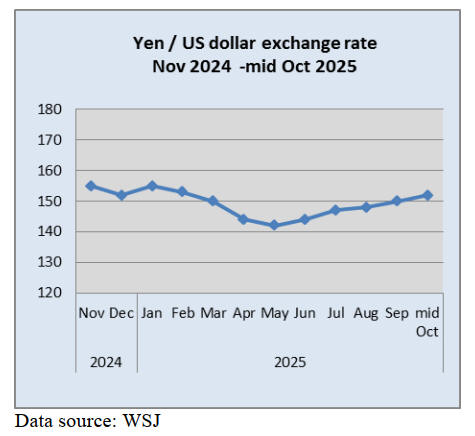
Osaka Expo a resounding success
As the 2025 Osaka Expo ends after six months, despite a
host of problems, it has been deemed a resounding success
in terms of attendance and finances. Debate is now
focused on what to do with the Grand Ring.
The Grand Ring is a building designed by Sou
Fujimoto built using traditional wooden joinery
techniques. The Grand Ring covers an area of over 61,000
square metres, making it the largest wooden architectural
structure on earth according to the Guinness Book of
World Records.
While calls to “save the ring” have intensified in recent
days, officials have so far not shown signs of reviewing
the decision that only a 200-metre portion of the entire
ring will be preserved. Apart from some timber earmarked
for reuse in public housing being built in earthquake-hit
Suzu, Ishikawa Prefecture, most of the components could
be turned into wood chips.
The Expo is forecast to have generated a profit of up to
yen28 billion according to the organisers. Robust sales of
admission tickets and goods related to the Expo's official
mascot have pushed up expo revenue. A total of 22 million
admission tickets were sold surpassing the break-even
level of 18 million.
See:
https://www.japantimes.co.jp/news/2025/10/10/japan/society/call
s-for-full-preservation-of-osaka-expo-grand-ring/
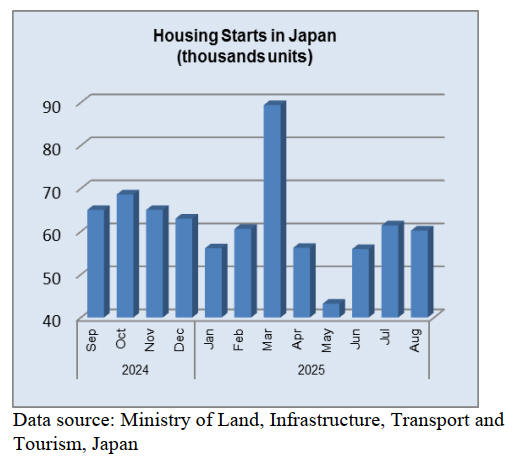
Import update
Assembled wooden flooring imports
The value of imports of assembled wooden flooring
continued its upward trend in August rising 83% year on
year and by 20% compared to a month earlier. After an
erratic few months in the second half of the year
residential housing starts settled into a more normal trend
with no significant increase in monthly starts.
Over the past few months the yen has weakened slightly
but not by enough to have pushed up import cost by so
much to explain the rise in flooring imports. This leaves to
possibility that it is demand in the non-residential sectors,
commercial and hospitality. That is driving flooring
demand.
The main category of assembled flooring imports in
August 2025 was HS441875, accounting for 60% (62% in
July) of the total value of assembled flooring imports. Of
HS441875 imports, 80% was provided by shippers in
China, the US, Thailand and Viet Nam. The second
largest category in terms of value in July 2025 was
HS441879, 72% of which was shipped from the US, a
marked change, with a further 20% being shipped from
China.
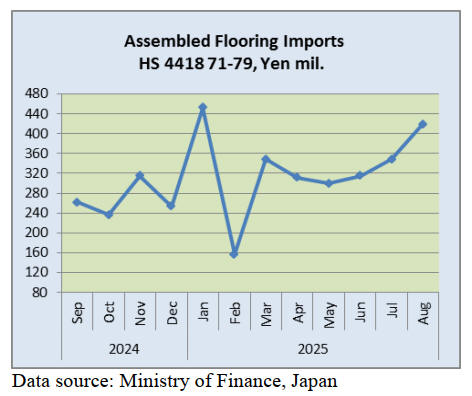
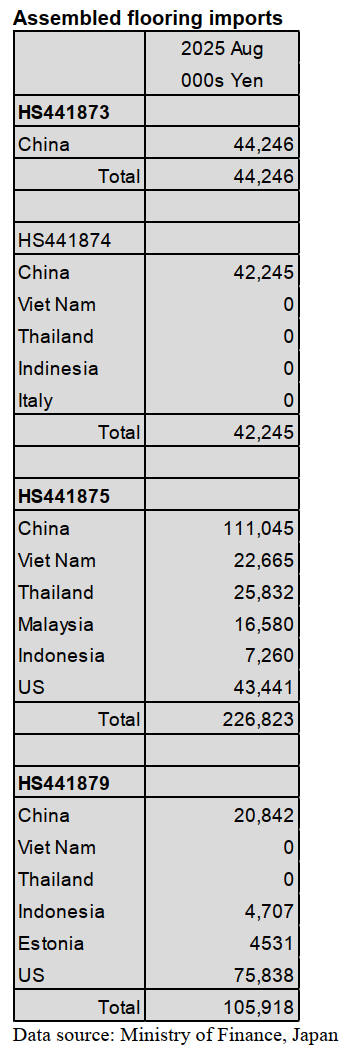
Plywood imports
In August, Malaysia and Indonesia were the top suppliers
of plywood to Japan, as in previous months providing over
80% of plywood imports. August 2025 import volumes
were 15% below those in August 2024 and 15% below the
volume of shipments in July 2025.
The volume of August 2025 imports from Malaysia fell
sharply, dropping almost 40% compared to a month earlier
but Indonesia saw a modest rise in the volume of
shipments in August. The volume of plywood arrivals
from both Viet Nam and China were down month on
month.
In August 2025 arrivals of HS441210-39 were reported at
110,998 cu.m (137,732 cu.m in July). As in previous
months, of the various categories of plywood imported in
August 2025 HS441231 (80% plus) followed by
HS441233 and HS441234 and the balance was of
HS441239.
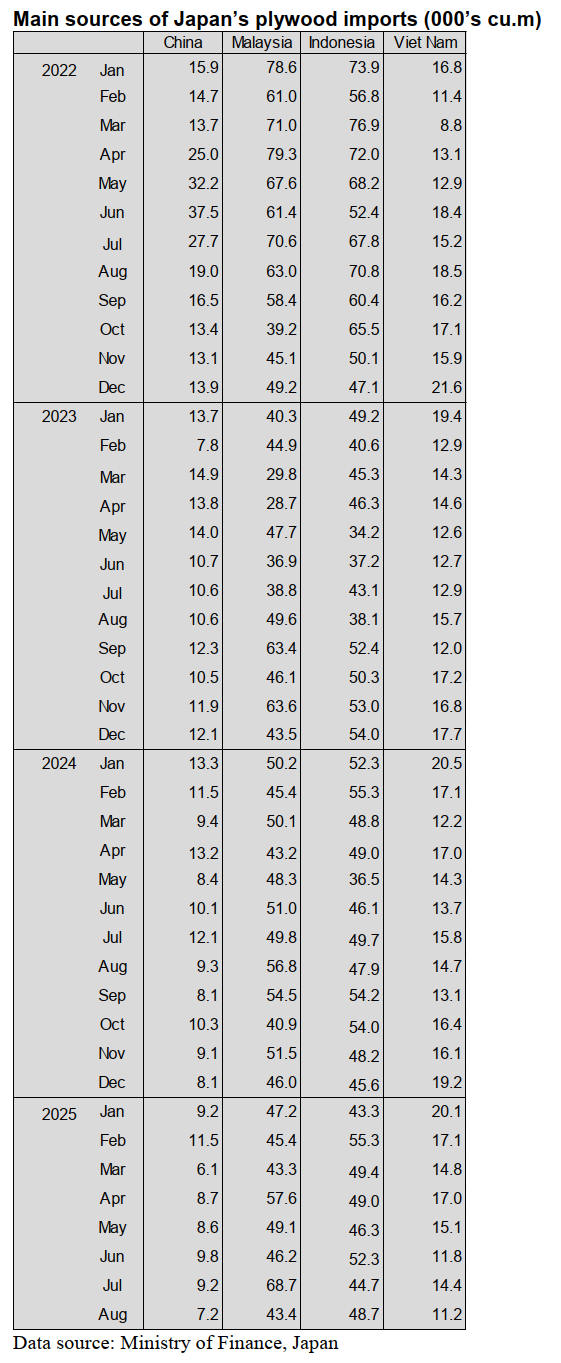
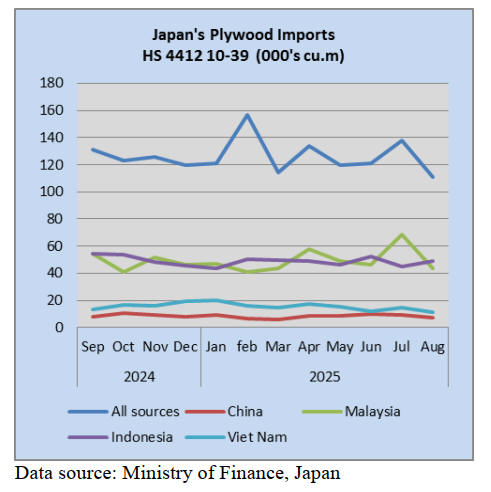
Trade news from the Japan Lumber Reports (JLR)
The Japan Lumber Reports (JLR), a subscription trade journal
published every two weeks in English, is generously allowing the
ITTO Tropical Timber Market Report to reproduce news on the
Japanese market precisely as it appears in the JLR. For the
JLR report please see: https://jfpj.jp/japan_lumber_reports/
Wood-based building material made from cedar
Haseko Corporation has begun construction of its own
factory in Gojō City, Nara Prefecture, to manufacture a
new wood-based building material called "HS Wood"
made from cedar. The total investment, including the
building and production equipment, amounts to
approximately 5 billion yen. The factory is scheduled for
completion in February 2027, with full-scale production
set to begin in April 2028. The annual production capacity
is expected to reach up to 15,000 cbms.
HS Wood is an engineered wood product made by
layering and pressure-bonding strands, wood pieces cut
from cedar logs, with their grain aligned lengthwise. A
patent application is currently pending. Because it is
unaffected by knots and can utilize small-diameter and
curved logs, HS Wood is expected to promote greater use
of cedar.
The HS Wood factory site covers 41,670 square meters,
with the main plant building occupying 8,236 square
meters and the administrative building 333 square meters.
The factory building will be a single-story steel structure,
while the administrative building will be a two-story
wooden structure.
HS Wood was developed through joint research with the
Advanced Wood Processing Institute at Akita Prefectural
University and the University of Kitakyushu. The cedar
used as raw material is planned to be sourced primarily
from areas surrounding the factory, with a focus on Nara
and Wakayama Prefectures.
Volume of composite wood flooring in 1st half of 2025
Production and sales volume of composite wood flooring
from January to June, 2025 remain roughly at the same
level as last year.
New starts in the first half of 2025 are 7.5 % less than the
same period last year but production of composite flooring
declined by 0.4%, and sales volume decreased by 0.6%,
remaining roughly in line with the previous year.
Production volume of direct-install soundproof flooring
reached 47,000 tsubo for LL40, a 14.5% increase, and
928,300 tsubo for LL45, a 1.8% decrease. Sales volume of
LL40 reached 49,300 tsubo, an increase of 8.8%, while
LL45 recorded 911,700 tsubo, a decrease of 4.1%. Some
have pointed out that the increase in demand for direct-
install flooring, driven by efforts to reduce apartment floor
heights amid rising construction costs, contributed to the
growth of LL40.
By surface finish type, specially processed decorative
surfaces accounted for 78%, up 1 percentage point, while
natural wood finishes made up 22%, down 1 point. By
base material type, MDF combined with domestic
plywood accounted for 39%, while MDF combined with
imported plywood made up 27%.
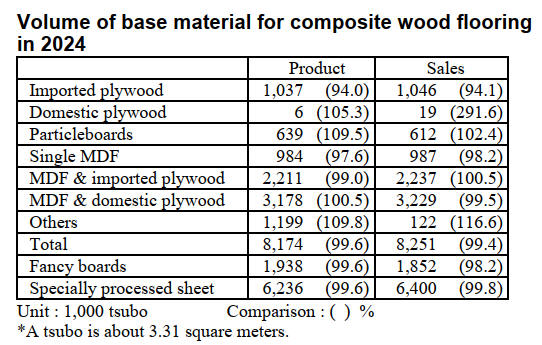
Import of European lumber
Arrival volume of European softwood lumber in January
to June, 2025 is 1,037,000 cbms, 5.7 % more than January
to June, 2024. For the first time in three years since 2022,
the volume has reached the one-million-cubic-meter range.
The increase was driven by a rise in non-planed and non-
sanded materials, mainly laminates, which grew to
682,000 cbms, an 11.0% increase.
Imports of non-planed and non-sanded materials, mainly
used for studs and similar applications, increased from
Northern Europe but declined significantly from Central
Europe, resulting in a total decrease to 350,000 cbms—
down 3.2%.
In 2025, although the import volume in March dropped
significantly to the 110,000-cubic-meter range, monthly
volumes for the rest of the year remained steady between
170,000 and 200,000 cbms.
In the first half of 2025, housing starts declined by 7.5%
year-on-year, indicating a sluggish market. In contrast,
imports of laminated wood products increased by 11.0%.
However, unlike in the previous year or in 2022 following
the wood shock, there have been no reports of excessive
inventory accumulation.
Imports of structural laminated timber declined by 18.0%,
a sharper drop than housing starts, prompting increased
inquiries to domestic laminated timber manufacturers for
replenishment purchases.
Volume of pine products, including redwood laminates,
increased to 473,000 cbms—up 15.7%. Spruce, fir, and
other species including whitewood also increased to
209,000 cbms—up 1.7%—but the growth in pine was
more pronounced.
North American logs
Domestic demand for logs in Japan remains sluggish and
incoming volumes have also declined. There are reports
that major sawmill manufacturers are adjusting
theirproduction accordingly.
The price of Douglas fir logs for lumber use bound for
Japan remained flat at around US$1,020, FAS,MBM
,Scribner scale for IS-grade logs in September shipments
to major buyers. However, overall prices reportedly
declined by $10 to $20 due to falling market prices in the
U.S.
The price of Canadian Douglas fir log for plywood is $220
– 221, CIF per cbm and the priced is unchanged from July.
The import cost would be around 34,100 yen, FOB per
cbm if the yen were 147 yen against the US dollar.
The price of 105 x 150 – 270 mm KD Douglas fir beam is
68,000 – 71,000 yen, delivered per cbm.
The KD Douglas fir square is around 80,000 yen,
delivered per cbm. 60 x 45 mm KD Douglas fir lumber is
85,000 – 88,000 yen, delivered per cbm.
South Sea logs and products
Among South Sea and Chinese wood products, there is a
growing sense of shortage for Indonesian merkus pine
laminated free boards.
Typically, July and August mark the peak of the dry
season in the region, a time when harvesting of merkus
pine progress actively. However, this year has seen
irregular weather continued, hindering logging operations.
As a result, delivery delays of one to two months have
occurred.
Domestic distributors remain focused on securing supplies
tailored to immediate operational needs. Such delivery
delays are the first of their kind since the COVID-19
pandemic. As shipments have generally arrived without
notable delays until now, distribution inventories remain
low.At present, the supply of South Sea logs has not been
affected.
Weather conditions in Borneo, where Malaysia’s Sabah
and Sarawak states are located, remain stable and no
significant factors have emerged to reduce log output.
Papua New Guinea is showing a similar trend, with a
stable outlook for securing the necessary volume of South
Sea logs. Amid weak domestic demand, distributors are
narrowing their procurement. However, with weather
conditions deviating from past norms, they are now facing
unexpected shortages.
Russian lumber imports in the first half of 2025
Imported Russian lumber in January to June, 2025 is
299,669 cbms, 13.4 % more than January to June, 2024.
Although it has increased for two consecutive years, it has
yet to return to pre-2022 levels. Planed finished products
such as imported red pine rafters totaled 178,374 cbms, up
10.6%, while rough sawn boards and lamina reached
118,249 cbms, up 19.5%—both showing increases of over
10%.
Since late February this year, shipments have generally
arrived as scheduled. Domestic distributors have shown
little appetite for procurement, limiting purchases to the
bare minimum.
However, due to stagnant domestic demand, inventories of
Russian lumber have been increasing at major ports in the
Kanto region, leading to signs of oversupply in items such
as 30×40 mm red pine rafters and battens.
In the Tokyo metropolitan area, wholesale prices for
premium-grade Russian red pine rafters remained flat in
the first half of the year, trading at around ¥104,000 to
¥105,000 per cbm.
|